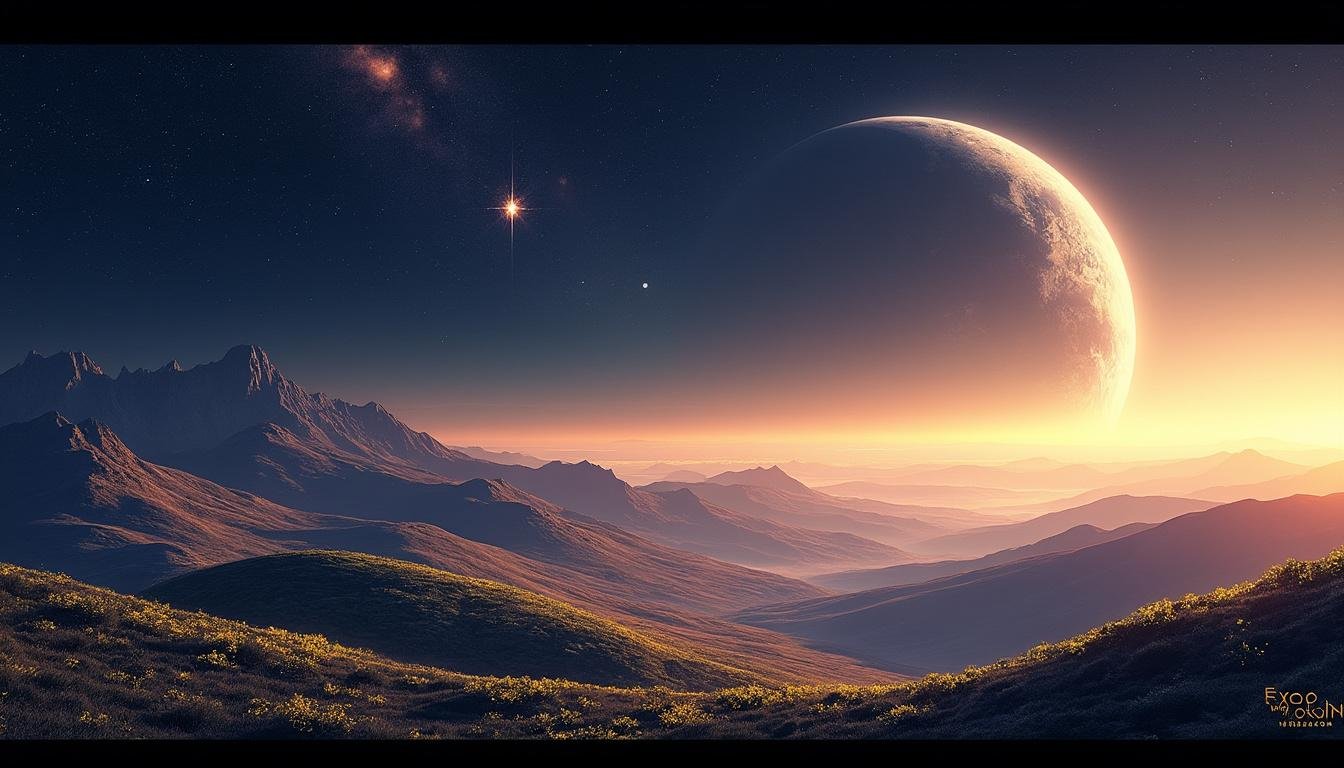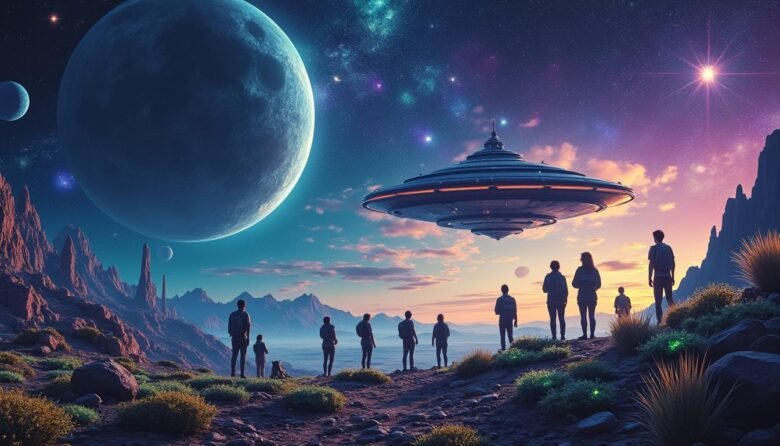En bref
- The age-old question “Are we alone?” sits at the intersection of science, imagination, and public curiosity, with robust investigations advancing into a new era of technology and collaboration.
- Scientists weigh evidence from telescopes, probes, and listening campaigns, while acknowledging the limits and ambiguities of what counts as proof of life beyond Earth.
- Exoplanet discoveries, biosignature research, and rapid developments in spaceflight and data analysis are expanding the horizon of what we consider habitable or detectable—even in settings far beyond our solar system.
- Public culture, media outlets, and educational institutions shape the conversation, highlighting both genuine scientific progress and the challenges of separating signal from noise.
- As we approach the mid-2020s, the partnership between agencies, universities, private ventures, and science media remains critical to interpreting findings and guiding future exploration.
In the vastness of space, humanity continues to ask whether life exists beyond our home planet. The scientific community approaches this question with a blend of curiosity and methodological rigor, seeking to transform speculation into evidence. From a historical sense of wonder to the modern practice of detecting faint biosignatures on distant worlds, the search is as much about understanding life as it is about understanding the universe. The narrative is shaped by a tapestry of missions, telescopes, and listening campaigns, all coordinated by major organizations and popularized by media partners that span from NASA to the Discovery Channel and BBC Earth. The year 2025 marks a convergence: more powerful instruments, broader international collaboration, and a public more engaged than ever before. Yet the core challenge remains: how do we distinguish genuine signs of life from natural processes or misinterpretations? The pursuit is as much about refining questions as it is about finding answers, and the journey itself illuminates our place in the cosmos.
Are We Alone in the Cosmos? A Historical Overview of the Search for Extraterrestrial Life
For centuries, observers have scanned the skies and imagined what lies beyond the familiar world. In ancient cultures, celestial patterns guided calendars and myths; later, the scientific revolution reframed the heavens as a laboratory for observation and inquiry. The modern inquiry into extraterrestrial life began to crystallize in the 19th and 20th centuries as astronomy shifted toward quantitative methods and instrumentation. The mid-20th century witnessed a leap: the concept of life beyond Earth moved from fantasy to a testable hypothesis. This transformation was catalyzed by pivotal ideas and projects that mapped new territory for exploration. The Drake Equation, introduced in the 1960s, offered a framework to estimate the number of communicative civilizations, inviting scientists to break down the problem into testable components rather than abstract speculation. The SETI Institute and affiliated programs popularized the discipline of listening for extraterrestrial signals, while NASA and other national agencies funded a lineage of missions aimed at detecting life-friendly environments and gather biosignatures. The search has since evolved from radio listens to spectroscopic assessments of atmospheric chemistry, from curiosity-driven probes to targeted studies of planets around distant suns, and from solitary theorists to expansive, multidisciplinary collaborations. The historical arc thus reveals a transition from wonder to a disciplined enterprise that remains open to extraordinary possibilities, tempered by the complexities of measurement, interpretation, and context. This evolution is not merely about finding life; it is about cultivating a broader understanding of what life means in a universe that can surprise us in every dimension.
Key milestones that have shaped the journey include a sequence of conceptual and practical steps: the idea that life could exist beyond Earth, the design of experiments to detect signs of life, and the accumulation of data from diverse sources. In the early decades, the focus was on Mars and the outer planets as potential hosts for life, while the latter part of the 20th century and the early 21st century brought a broader, more inclusive search canvas that includes exoplanets and their atmospheres. The cumulative impact of these milestones has been to set expectations and to calibrate our methods. Today, the search continues to be refined by international collaboration, advances in computational analysis, and a public culture that remains receptive to both scientific discoveries and speculative narratives. The result is not a single verdict but a progressive understanding—the cosmos is populated with surprising possibilities, some of which might eventually be found in the signals we detect, the signatures we observe, and the worlds we or our instruments study.
Evidence and conjecture coexist in a dynamic ecosystem of science communication. The NASA missions, the work of the SETI Institute, and the on-air storytelling of National Geographic, Discovery Channel, BBC Earth, and History Channel — alongside technology developers like SpaceX and the computing power of brands such as Alienware — all shape how the public perceives the search. Through these channels, the scientific process becomes accessible, with open data, transparent methods, and ongoing debates about what constitutes robust evidence. The Roswell UFO Museum and related cultural institutions remind us that the conversation extends beyond laboratories, into museums, forums, and popular culture where questions about life elsewhere inspire imagination and critical thinking alike. In this evolving landscape, the most compelling progress may lie in the integration of disciplines, the expansion of observational horizons, and a renewed commitment to rigorous, repeatable science. The journey continues, and with it, the possibility that we are not alone may gradually move from possibility to probability to a profound, shared understanding of our place in the universe. NASA, SETI Institute, and a constellation of partners remain at the heart of this ongoing exploration.

Foundations, Methodologies, and Milestones
The search for extraterrestrial life rests on a blend of foundational questions, methodological frameworks, and pivotal milestones that together map the path from curiosity to evidence. The early stages of inquiry were anchored in philosophy and observational astronomy, but they matured into a scientific program when researchers began to formalize the criteria for life beyond Earth. At the core is the recognition that life, as we understand it, requires a set of conditions — liquid water, energy sources, and the chemistry that can sustain complex processes — that may be met in environments far from Earth. The modern toolkit includes remote sensing to identify habitable environments, spectroscopy to infer atmospheric compositions, and radio or optical (light-based) listening campaigns to detect signals that could indicate intelligent life. Institutions such as the SETI Institute have championed the “listen first” approach, while space agencies like NASA have funded missions that look for biosignatures in planetary atmospheres or seek evidence of prebiotic chemistry on other worlds. This multi-pronged strategy is reinforced by data-sharing platforms, international collaborations, and cross-disciplinary teams that integrate astronomy, planetary science, biology, and computer science. The evolution of techniques—from radio astronomy to transit spectroscopy and direct imaging—illustrates how technological advancement expands the boundaries of what we can detect and understand. The field remains anticipatory; even when signals are not definitive, the process of tightening hypotheses, validating interpretations, and communicating uncertainties is central to credible science. The evolving consensus is that life, if present elsewhere, may reveal itself through subtle patterns rather than dramatic revelations, and the search is as much about refining our questions as about discovering a final answer. National Geographic and other media partners, by documenting these developments, help translate complex science into accessible narratives, inviting a global audience to participate in the exploration.
| Milestone | Year | Significance | Reference/Institution |
|---|---|---|---|
| Drake Equation formalization | 1961 | Quantified factors influencing the number of communicative civilizations | ARPA/NASA collaborations |
| Arecibo message broadcast | 1974 | Symbolic attempt to communicate with potential civilizations | SETI/Radio Astronomy |
| First exoplanet around a main-sequence star | 1995 | Proof that planets exist around other stars, expanding life-habitable horizons | Astronomy Community |
| Kepler mission launch | 2009 | Systematic census of transiting exoplanets, enabling habitability assessments | NASA |
| James Webb Space Telescope (JWST) operations | 2022–present | High-sensitivity spectroscopy for atmospheric biosignatures | NASA/ESA |
| Inspired public dialogue via media partnerships | Ongoing | Broader understanding of the search and its implications | National Geographic/Discovery Channel/BBC Earth |
What these steps reveal is a steadily expanding field where science, media, and policy intersect. The question is no longer whether life might exist somewhere in the cosmos; it is how we detect, interpret, and communicate any signs without misrepresenting uncertainty. The conversation remains lively and dynamic, shaped by new discoveries, fresh data, and ongoing debates within the scientific community. The 2025 landscape sees a more integrated ecosystem: ground-based observatories, space telescopes, data archives, and citizen science projects increasingly enabling more people to participate in the quest. This collaborative momentum is essential, because the universe does not yield its secrets easily, and the stakes are high: understanding life beyond Earth informs not only biology and planetary science but also philosophy, ethics, and our long-term plans for space exploration. As our instruments become more capable, so too does our responsibility to interpret results with rigor, humility, and transparency. In that sense, the search is a mirror, reflecting our own capacity for curiosity, cooperation, and stewardship of knowledge.
The empirical backbone of the extraterrestrial life question rests on whether we can gather reliable signals or patterns that cannot be easily explained by terrestrial processes. This section surveys the spectrum of evidence—from radio and optical signals to biosignatures in atmospheres—while carefully weighing alternatives and uncertainties. The field is characterized by a tension between excitement and skepticism: extraordinary claims require extraordinary confirmation, and researchers continually refine criteria to avoid overinterpretation. A robust approach combines multiple lines of evidence and emphasizes reproducibility, independent verification, and transparent methodologies. This is where organizations such as the NASA and the SETI Institute play crucial roles, coordinating observations, sharing data, and developing standards for evaluating potential signals. The public dimension—through media partners like National Geographic, Discovery Channel, and BBC Earth—adds accountability and reach, but also increases the need for methodological clarity to prevent sensationalism from distorting interpretation. The dynamic interplay between data and discourse is essential for maintaining scientific integrity while keeping the conversation accessible and engaging for diverse audiences. Below is a curated set of signals and debates that illustrate how evidence is gathered, assessed, and contested: In evaluating these signals, the field relies on well-established criteria for evidence, often summarized in frameworks that require robust reproducibility, credible statistical support, and careful consideration of false positives. Researchers emphasize that a single unusual observation rarely constitutes proof of life; instead, a converging pattern of independent lines of evidence strengthens the case. This cautious posture is essential when public narratives can turn tentative findings into definitive statements. The interplay between the scientific method and popular discourse remains a defining feature of the search, challenging both scientists and journalists to convey uncertainty without dampening imagination. Meanwhile, the public, informed by outlets such as Science Channel and History Channel, follows the evolving story with enthusiasm, while institutions like the Roswell UFO Museum remind us that the cultural dimensions of the question persist alongside empirical work. The 2025 landscape thus features a more nuanced, evidence-driven conversation that respects the boundaries of current knowledge while keeping the door open for unexpected breakthroughs. Evidence, Signals, and Skepticism: Decoding the Data Behind Extraterrestrial Life
Signal/Observation
Source/Context
Current Assessment
Notable References
Wow! signal
Radio astronomy, 1977
Unexplained anomaly; not replicated; not proven to be intelligent
SETI records, peer-reviewed discussions
FRB 121102 and repeats
Radio telescopes; extragalactic origin
Astrophysical, typically natural; no definitive techno-signature
NASA/CHIME findings
Biosignature gases in exoplanets
Transit spectroscopy, JWST era
Promising indicators; context-dependent; requires corroboration
NASA archives, Nature/Astro journals
Methane in Martian atmosphere
Mars orbiters/rovers
Ambiguous; could be geological or biological
NASA Mars missions
Clouds of Venus as life habitats
Venusian atmosphere studies
Speculative; modern missions test hypotheses
Planetary science analyses
Habitability science centers on identifying environments where life as we know it could arise or persist. This requires a careful blend of theoretical modeling and observational data to map the so-called “habitable zone” around stars, where planetary surface conditions might allow liquid water. But habitability is not a simple yes-or-no proposition. It depends on factors such as atmospheric composition, planetary mass, heat sources, magnetic fields, and geological activity. The discovery of thousands of exoplanets, including Earth-sized worlds in temperate orbits, has expanded the scope of possible habitats beyond our solar system. Teams using transit methods, radial velocity measurements, and direct imaging have begun to characterize planetary atmospheres, even detecting gases that, under certain conditions, may indicate biological activity. Yet the spectrum of possible biosignatures is broad: oxygen and ozone can be produced abiotically under some circumstances, while methane can arise from geological processes as well as biology. Thus, scientists emphasize the importance of context—coupling atmospheric chemistry with planetary temperature histories, star type, and potential surface processes to differentiate true biosignatures from false positives. Within this framework, several concrete topics deserve attention. First, the concept of a biosignature is not a single molecule but a set of indicators that could co-occur and reinforce one another. Second, the role of biosignatures in exoplanet atmospheres requires high-precision spectroscopy, often at wavelengths that demand next-generation facilities and collaborative data analysis. Third, the detection of life requires careful disentanglement from abiotic phenomena and instrumental noise, and researchers pursue multiple observational strategies to cross-validate findings. The interdependence of theory and observation is evident in the way researchers construct models of planetary climates, chemical pathways, and biological plausibility. The modeling process benefits from data shared by NASA missions and affiliated observatories, while public audiences engage through major media outlets that translate scientific nuance into accessible narratives. The collaboration among scientists, instrument engineers, and science communicators is vital for advancing understanding while maintaining credibility. In this sense, exoplanet biosignature research is a frontier where science, technology, and storytelling converge to illuminate possibilities about life elsewhere in the cosmos. For researchers, the practical path forward involves combining space-based observatories like NASA infrared capabilities with ground-based telescopes and data science pipelines. The synergy among spectroscopy, high-resolution imaging, and atmospheric modeling is essential to interpret observations robustly. The public audience plays a crucial role by supporting science funding, engaging with educational programs, and following developments through outlets such as National Geographic, BBC Earth, and Science Channel. In parallel, institutions like the Roswell UFO Museum remind us that culture and curiosity beyond the lab contribute to how society processes these ideas. As we advance, it will be increasingly important to maintain transparent communication about uncertainties, to celebrate methodological breakthroughs, and to recognize the incremental nature of discovery in the cosmic search for life. The field invites us to imagine, to question, and to participate, while remaining anchored in careful, reproducible science.Habitability, Biosignatures, and the Search for Life in Exoplanets
Biosignature/Signature
Why It Matters
Potential False Positives
Examples
Oxygen (O2) & Ozone (O3)
Potential indicator of sustained photosynthesis or strong redox processes
Abiotic photolysis or photochemical cycles
Exoplanet atmospheric analyses; JWST-era studies
Methane (CH4) in disequilibrium
Biological production plausible in some environments
Geological or photochemical sources
Planetary atmospheres exploration
Water vapor signatures
Liquid water as a solvent is a key enabler of chemistry
Water from non-habitable processes
Atmospheric measurements of temperate worlds
Phosphine or exotic gases
Hypothetical or context-dependent indicators
Instrumental artifacts, non-biological chemistry
Targeted missions and follow-ups
Habitable worlds depend on a mosaic of conditions that could support life as we know it, but the precise boundaries are themselves a fertile area of debate and discovery. Theoretical work on the “habitable zone” around stars has evolved from simple distance-based estimates to nuanced models that account for stellar type, planet mass, greenhouse effects, atmospheric retention, and tidal heating. The current consensus suggests that habitable zones are not uniform across the galaxy; rather, they vary with the star’s spectral class, planetary properties, and the long-term evolution of climate. Observationally, astronomers identify candidate planets through transit observations, radial velocity measurements, microlensing, and eventually direct imaging for a subset of nearby worlds. The first task is to establish the planet’s basic properties: size, mass, orbital period, and environmental context. The second task is to characterize the atmosphere and surface conditions to assess the likelihood of liquid water and energy sources that could sustain metabolism. These steps are iterative: initial detections prompt targeted follow-ups, which in turn refine models of potential habitability. The 2020s have seen an acceleration of discoveries, with new exoplanets populating the parameter space of possible Earth-like worlds, encouraging a broader, more data-driven approach to habitability that integrates planetary science, atmospheric chemistry, and astrobiology. Within this framework, biosignatures become a richer notion than a single chemical signal. Scientists consider chemical disequilibria, spectral features, and temporal variations in atmospheric composition as potential clues. There is also growing interest in alternative biochemistries and subsurface reservoirs that could harbor life in environments unlike Earth. The ongoing work draws on a spectrum of instruments—from near-infrared spectrographs to high-contrast imaging systems—paired with computational advances in data processing and machine learning. The collaboration across institutions, including universities, government labs, and private enterprises, strengthens the reliability of results and broadens the scale of inquiry. Popular science media, including Discovery Channel and National Geographic, help translate these complex ideas into accessible stories about distant worlds and the people who study them. As research progresses, the habitability question remains open-ended: we may identify worlds that plausibly sustain life, but proving life itself will require converging evidence from multiple, independent lines of inquiry. The exploration thus continues to be as much about understanding the diversity of planets as about understanding life itself. When evaluating habitability, scientists emphasize that “Earth-like” is a useful anchor but not the exclusive standard. The diversity of planetary environments invites creative hypotheses about life that might not resemble our carbon-based biology. This broader perspective aligns with the collaborative ethos of the community, encouraging cross-disciplinary dialogue and experimentation. Public engagement channels—from NASA briefings to BBC Earth documentaries—play a role in shaping expectations and inspiring future generations to contribute to the search. The integration of new missions and observational campaigns promises to broaden our understanding of where life could exist, while rigorous data analysis ensures that any claim is responsibly supported by evidence. As we map the cosmos with ever greater precision, the habitability question remains a central guidepost, steering research toward worlds where life might plausibly thrive—and toward the discoveries that could rewrite our understanding of biology, ecology, and the very definition of life itself.The Habitable Universe: How We Define Life-Friendly Worlds and What We Look For
Aspect
Key Consideration
Measurement Tools
Representative Worlds
Habitable zone definition
Temperature constraints and liquid water potential
Astrometry, transit timing, climate modeling
Various Kepler/TESS discoveries
Atmospheric composition
Biomarkers vs abiotic sources
Transit spectroscopy, JWST data
Venus-like or Earth-like atmospheres under study
Habitability longevity
Stellar evolution and planetary cooling
Stellar models, geological analogs
Long-term climate simulations
Aspect
Current State
Future Prospects
Atmospheric biosignatures
Probabilistic indicators with high uncertainty
Higher confidence through multi-wavelength observations
Direct imaging
Limited to nearby, bright systems
Expanded capabilities with future large telescopes
Solar system analogs
In-situ data from Mars/outer moons
New missions to icy worlds and ocean-bearing bodies
The question of whether we are alone resonates beyond laboratories and observatories; it lives in museums, documentaries, novels, and online dialogues. Cultural institutions and media outlets interpret scientific progress for diverse audiences, translating complex results into narratives that educate and inspire. The interplay between science and storytelling helps build public support for research while fostering critical thinking about extraordinary claims. In this dynamic, organizations such as National Geographic, Discovery Channel, and BBC Earth play a central role in shaping the conversation around life beyond Earth. They collaborate with scientists to present evidence-based perspectives, highlight ongoing missions, and showcase the people behind the discoveries. The engagement extends to educational programs, public lectures, and citizen-science initiatives that invite broad participation while emphasizing scientific rigor. Meanwhile, public interest is sustained by a constellation of institutions and media brands, from History Channel to Science Channel, which generate content that ranges from documentary explorations of planetary science to speculative analyses of potential encounters. The presence of culture in the discourse is not merely decorative; it helps to contextualize scientific work within human history, ethics, and the shared curiosity that has driven exploration for centuries. And as public interest grows, institutions such as the Roswell UFO Museum remind us of the enduring tension between anecdote, belief, and evidence, encouraging a careful, evidence-based approach to extraordinary claims. The synergy among science and media fosters an informed public that can participate in policy discussions, support research funding, and engage with educational initiatives across generations. In this sense, the search for life beyond Earth becomes a platform for science literacy, cross-cultural dialogue, and the imaginative exploration of what it means to be human in a vast cosmos. Public perceptions are further influenced by cultural artifacts and memes that frame the cosmic question in compelling ways. Classic science fiction, theatre, and cinema have long imagined contact scenarios, while contemporary media continue to explore realistic possibilities through documentary-style storytelling and expert interviews. The Roswell UFO Museum stands as a reminder that public interest often blends curiosity with skepticism, a mix that can drive demand for transparent data and careful interpretation. This cultural milieu is not a distraction; it is a driver of science literacy and critical inquiry, prompting researchers to communicate uncertainties clearly and to celebrate rigorous methodologies. As the debate evolves, the collaboration among science institutions and media creators will shape not just what we know, but how we share what we know with audiences around the world—through trusted outlets and innovative formats that illuminate the big questions while respecting the complexity of the evidence. MyBuziness – Exploring the Existence of Humanity: Are We Truly Here?Cultural Imagination and Global Institutions: How Media and Science Shape Our View of Extraterrestrial Life
Entity
Role
Example Program/Content
NASA
Lead space agency driving missions and biosignature research
JWST science briefs, planetary habitability reports
SETI Institute
Research and public education on technosignatures
Listening campaigns, citizen science projects
SpaceX
Private sector propulsion and spaceflight enabling deeper exploration
Industry advancement and mission demonstrations
National Geographic
Science communication and storytelling
Documentaries and special reports on exoplanets
Discovery Channel
Television platform for science outreach
Programs on space exploration and astrobiology
Topic
Media/Institution
Impact
Representative Content
Public engagement
National Geographic, BBC Earth
Broad awareness and understanding of astrobiology
Documentaries and educational series
Historical perspective
History Channel
Contextualized storytelling about space history
Mini-series and archival explorations
Technical exposition
Science Channel
Deeper dives into methodology and instrumentation
Expert interviews and demonstrations
Looking forward, the path to resolving the question of whether we are alone hinges on continued technological innovation, international collaboration, and strategic outreach to the public. The next decade promises improvements in telescope sensitivity, data processing power, and mission design that will enable more precise measurements of exoplanet atmospheres, higher-resolution imaging of distant worlds, and broader searches for technosignatures. In particular, investments in ground- and space-based observatories—alongside powerful computing platforms—will expand our ability to examine planetary environments with unprecedented detail. The role of public-private partnerships, including collaborations with major technology brands and research consortia, could accelerate progress by enabling more ambitious missions and data-sharing frameworks. This era also invites a broader set of voices to participate in the conversation, from educators and students to hobbyists and citizen scientists who contribute to data classification, anomaly detection, and outreach efforts. The synergy between discovery and dissemination ensures that breakthroughs are not only achieved but well understood and communicated across cultures and languages. Strategic priorities for science institutions and funders include maintaining openness to novel hypotheses while building robust verification pathways. It means designing experiments and missions with built-in redundancies, transparent methodologies, and clear criteria for confidence levels. It also means recognizing that some discoveries may be incremental—revealing biosignature hints, refining atmospheric models, or identifying plausible habitable niches—before a decisive breakthrough occurs. In parallel, media and education partners will continue translating technical results into accessible formats that empower the public to engage with science critically and creatively. The collaboration among NASA, SETI Institute, SpaceX, National Geographic, Discovery Channel, BBC Earth, History Channel, Science Channel, and related cultural institutions will shape not only how we search for life but how we envision our future as an interplanetary species. And as computing becomes ever more capable, brands like Alienware stand as symbols of the computational might that helps scientists model, simulate, and visualize worlds beyond our reach. The quest is a long arc, but each milestone—whether a new exoplanet, a refined biosignature detection, or an international collaboration—adds to a cumulative narrative about life in the cosmos. The questions remain provocative, the challenges real, and the curiosity unbounded. Public engagement remains essential to sustaining momentum. Learning communities, museums, documentaries, and interactive platforms provide spaces to explore ideas, challenge assumptions, and celebrate scientific progress. The ongoing dialogue helps ensure that the search for life beyond Earth remains a shared human endeavor, guided by evidence, enriched by imagination, and anchored in a responsibility to convey findings accurately. As we advance, the universe may reveal new surprises—surprises that remind us of our own responsibility to explore with humility, curiosity, and a commitment to the well-being of future generations and the planets we study. The story continues, with NASA, SETI Institute, and a spectrum of media and educational partners leading the way toward ever-deeper understanding of whether we are truly alone.The Road Ahead: Technology, Collaboration, and Public Engagement in the Search for Life
Future Mission/Initiative
Goal
Expected Impact
Key Partners
Habitable Worlds Observatory (concept)
Characterize exoplanet atmospheres with high precision
Improved biosignature detection
NASA, international partners
JWST follow-ons
Deeper spectroscopic studies of distant planets
Deconvolution of atmospheric signals
NASA/ESA/CSA
Expanded SETI campaigns
Broader listening and candidate verification
Stronger statistical confidence
SETI Institute, universities
FAQ




